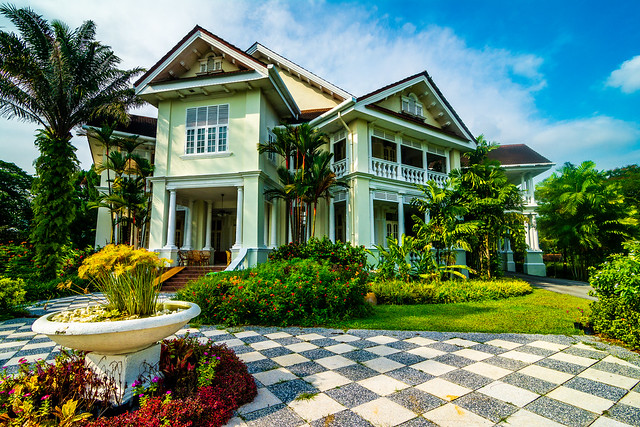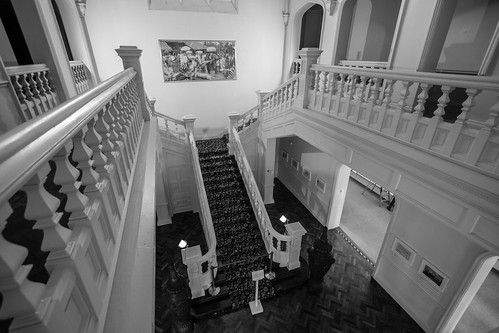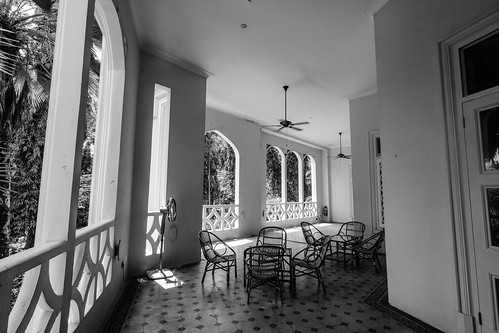Carcosa - Once the residence of the British Resident-General of the Federated Malay States (FMS)
 |
| Carcosa |
HISTORICAL BACKGROUND
The proposal in setting up a federation comprising four states namely Selangor, Perak, Negeri Sembilan and Pahang as what was called Federated Malay States was drawn up by Sir Frank Swettenham. In 1893, it was first brought up to Sir Cecil C. Smith, the Governor of The Straits Settlement, who was about to retire and it was forwarded for the consideration of the Secretary of State for the Colonies in England. When Sir Charles Mitchell took over from Sir Cecil C. Smith as the Governor of the Straits Settlement he was assigned to assess and report as to the advisability of adopting the proposal by Frank Swettenham on the Federated Malay States. Sir Charles Mitchell, after nearly two years' consideration, recommended that, if the Malay Rulers favoured the proposal, the federation should be adopted.
On 1 July 1896, the agreement was signed and the four states were officially federated under one administration headed by Sir Frank Swettenham himself holding a new position of Resident-General. As a new Resident-General he needed a new official residence while the existing mansion called the Residency was occupied by the existing Resident of Selangor, the post that still existed under the new Federated Malay States.
 |
| The Residency still remains intact today. |
The new Resident-General assigned the State Engineer of Selangor, CE Spooner, to build a new residence for him befitting his status. Arthur Benison Hubback who had recently arrived in Selangor to work as the draughtsman and later assistant architect was responsible for the design of the new house. The architectural style adopted was neo-Gothic and Tudor-revival.
According to JM Gullick in his journal 'Governor's house' the construction of the new house took time, and in the meantime, for a about two years while the Resident-General's new residence was being built, Swettenham, who was often away, had the use of a house which was later retrospectively known as the 'Old Carcosa'.
JM Gullick further wrote:
The site of the R-G's (Resident-General's) new house was on high ground overlooking the Lake Garden. Some twenty four acres of sloping land was excised from the Lake Gardens to become the private grounds of the new official mansion. Four acres were developed as gardens and the remainder became open park land where sambhur (sambar) deer could be seen amidst the bushes. The ground floor of the interior was planned to accommodate major social gatherings. There were large and open reception rooms, running one off the other and so capable of use for a single large function. Upstairs there were seven main bedrooms, each with its own stretch of verandah, and a main breakfast verandah over the porch, with a private sitting room and study. The outbuildings included stables, and there were several tennis courts.That is how JM Gullick described the mansion which was considered grand for its time when compared to houses most of the Kuala Lumpur inhabitants lived in. In fact this new mansion for the newly appointed Resident-General was the sultan's palace standard.
According to H.S. Barlow in his journal entitled "The early history of the Residency, Kuala Lumpur", the new mansion was to some extent designed by Swettenham. Features the new mansion shares with the Residency (the official house of the Resident of Selangor) include the southward view, albeit from a greater distance, towards the centre of old Kuala Lumpur, and a downstairs office, similarly situated to that in the Residency, connected by a private staircase to bedrooms on the first floor.
Swettenham was said to have partly designed the Residency but didn't get around to using it when he had to leave Selangor to become the Resident of Perak at the end of May 1889.
In the meantime, the Public Works Department was at its busiest during the construction of the new residence for the Resident-General. It was at the same time the Government Offices (now the Sultan Abdul Samad Building) was being built which was a mega project in Kuala Lumpur back then. Swettenham decided to opt for neo-Gothic and Tudor-revival style as opposed to the Neo-Saracenic style chosen for the Government Offices building. The construction of the new mansion was undertaken by a private firm, Nicholas Walsh. & Co.
 |
| Carcosa, newly completed circa 1900s - the photo was reproduced from Governors' Houses article by JM Gullick, used without permission but in accordance with the principle of fair use |
The new house was named "Carcosa" by Swettenham himself. The reason it was named Carcosa used to be the subject of argument before as the name was considered strange. Sir Frank Swettenham wrote a letter to British Malaya magazine to clear the air although this happened only more than 30 years after his retirement.
He explained in his letter dated 19 April 1936 to the editor of British Malaya. Let me quote the letter below
The CarcosaThe cost of construction for the Carcosa was $69,000 Straits Dollars for roads, sites, stables and water supply plus the cost of the house, offices, kitchen and godowns amounting to $62,376 Straits Dollars.
To the Editor of “British Malaya”
[British Malaya, May 1936]
SIR,
In the April magazine your correspondent in Malaya asks me, in courteous terms, to tell him why I gave the name “Carcosa” to the house that was designed and built for me at Kuala Lumpur by the late Mr. C.E. Spooner, assisted by Mr. A.B. Hubback – as he was in those days – and I have no objection to answer the question even though the simple truth may spoil a number of excellent stories. When this house was finished and occupied I read a book which interested me. It was called “The King in Yellow” and at the beginning of this book there were some verses with a note explaining that they came from Cassilda’s song in “The King in Yellow”, Act 1, Scene 2. Here are two verses: -
“Strange is the night where black stars rise, And twin moons circle in the skies, But the stranger still is Lost Carcosa.”
“Song of my soul, my voice is dead; Die thou, unsung, as tears unshed Shall dry and die in Lost Carcosa.”
I did not call the Resident General’s dwelling “Government House,” or “King’s House,” because neither seemed an appropriate name in Protected States. I did not give it a Malay name, because it was to be the residence of a British Officer; so I took a book name as has often been done before.
As to the word Carcosa, I imagine it was the Castle of the King in Yellow, but the book explains nothing about either the place or its occupant. That apparently can be found in the play, to which there are only occasional allusions. Probably it is a word created by the author’s fancy, though it looks like a combination of the Italian words cara and casa and would mean “desirable dwelling,” as indeed I found it.
The only curious fact is that this name was prophetic for, as I understand, the house has lost its name and is thus, “Lost Carcosa.” The occupant, I am told, is now styled “F.S,” instead of “R.G.”
Yours obediently,
FRANK SWETTENHAM
19 April 1936.
A fancy dress ball was held by Frank Swettenham on 29th August 1898 to celebrate the opening of his official residence as reported by The Singapore Free Press and Mercantile Advertisers dated 8 September 1898. The event was attended by the British high-ranking officers serving in the British Colonial Government in Malaya (now Malaysia) together with their wife and other selected guests.
Subsequently he was promoted to the post of the Governor of the Straits Settlement and High Commissioner of the Federated Malay States effective 5.11.1901 and had to move to Singapore where he should be based as the Governor of the Straits Settlement. Swettenham was reported to have stayed in the Carcosa until 12.12.1901.
CARCOSA BEFORE AND AFTER INDEPENDENCE
During the Japanese Occupation, Carcosa became the home of a general and later a senior officers' mess. After the end of World War II the British Military Administration took over Malaya and Carcosa was back to its former role accommodating the most senior British officer in British Malaya.
This mansion holds a lot of historical significance for Malaysia, because it was here the nation’s independence agreement was signed. The last occupant before Malaya (now Malaysia) achieved independence was Sir David Watherston who retired a fortnight after he had witnessed the solemn ceremony that changed the Federation of Malaya into an independent state. Sir David closed the chapter of Carcosa's pre-independence history by acting as host to the Duke of Gloucester, who came as representative of Her Majesty the Queen to present the constitutional instruments of freedom to the Prime Minister of Malaya.
And, as a salute to the friendship with Great Britain, the new Government presented Carcosa and its 40 acres of land to Britain to be used by her as home of the High Commissioner of Britain.
However, when Dato' Seri Dr. Mahathir Mohamad (now Tun) became the fourth Prime Minister, the Carcosa "issue" was taken up by young radical politicians, in particular Anwar Ibrahim (now Dato' Seri), Daim Zainuddin (now Tun) and Dr. Mahathir Mohamad, himself. It was said that Tun Daim Zainuddin successfully led the campaign for the Malaysian government to own it, yet again. In 1987, possession of the Carcosa estate was returned to the Government of Malaysia.
Together with the adjacent building, which was the former King's House (renamed Seri Negara), the two colonial mansions were extensively refurbished and first leased to Landmark Hotels and Realty Sdn Bhd on a 10-year renewable contract basis. As a result Carcosa and Seri Negara served as the luxury boutique hotel and were operated under a brand name of Carcosa Seri Negara beginning from 1989 when all the facilities were ready. The mansions' colonial architecture and interior designs complemented the colonial-themed hotel service perfectly. In its inaugural year as a hotel, Carcosa Seri Negara served as the temporary official residence for Queen Elizabeth II and Prince Philip during the 1989 Kuala Lumpur Commonwealth Heads of Government Meeting.
However since 2004 the management of Carcosa Seri Negara was taken over by General Hotel Management Ltd (GHM).
The second 10-year lease expired on Dec 31, 2009, after which it was closed for refurbishment.
 |
| Seri Negara - Completed in 1913 |
Upon completion of refurbishment, only Seri Negara continued operation in January 2010 though, still under the same name – Carcosa Seri Negara.
It was then managed by Saujana Hotels & Resorts (SHR), the hospitality flagship of the Malaysian-owned Peremba Group. The lease to Peremba Group expired on 31 December 2015 which also marked the fifth anniversary of the closure of Carcosa.
In spite of its opulent British colonial exterior, the interior was fading away with ageing furniture, faded curtains and carpets to name a few. But the garden and its surrounding was well kept.
Between the two mansions, Carcosa is in worse condition as it has been abandoned and neglected at least for almost 10 years this year.
In July last year Hollywood chose the interior of Carcosa as the interior of fictional Tyersall Park, (while on the exterior, it is represented by Seri Negara) home of the matriarch played by Malaysian actress Tan Sri Michelle Yeoh in Crazy Rich Asians film. Below is the film still showing the actress Michelle Yeoh climbs the iconic bifurcated grand stairs of the Carcosa. Compare it with the picture I took 2 years ago of the stairs and the door at the end of the stairs.
 | |||
| Crazy Rich Asians - Photo credit: Warner Brothers Pictures |
 | |
|
Carcosa has also been featured in The 7th Dawn, a 1964 Technicolor drama film directed by Lewis Gilbert and starring William Holden, Capucine and Tetsuro Tamba. The film, set in the Malayan Emergency, was based on the 1960 novel The Durian Tree by Michael Keon and filmed on location in Malaysia.
In addition, a Singaporean Malay singer, Imran Ajmain, released his music video about 10 years ago to promote his song titled "Jika Engkau Pergi". What interests me is almost the entire music video was filmed at Carcosa, on its interior and exterior. Watch the music video below.
The New Straits Times dated 2 April 2017 reported that Carcosa and Seri Negara had been rented out to a 100 per cent Malaysian social enterprise, Asian Heritage Museum Sdn Bhd, as an Artefacts Trading and Performing (ATP) Arts Centre. The tenancy of the heritage buildings includes the staging of Asian martial arts, galleries and an educational history tour.
The then Natural Resources and Environment Minister Datuk Seri Dr Wan Junaidi Tuanku Jaafar however guaranteed that the status of Carcosa and Seri Negara as heritage buildings stipulated under the National Heritage Act 2005 would remain unchanged and intact.
The first event organised by Asian Heritage Museum (AHM) that took place at both Carcosa and Seri Negara was the Jalan Merdeka: Traversing the routes to Merdeka exhibition. The exhibition kicked off on 1 September 2017 and ended on 31 October 2017.
"The exhibition is curated to show different perspectives by highlighting the roles of normal people and not just the political elites," said AHM Council chairman Tunku Zain Al'-Abidin ibni Tuanku Muhriz.
Please check out this link for information on the Jalan Merdeka: Traversing the routes to Merdeka exhibition.
 |
| Carcosa, in the modern days (Photographed in February 2018) |
 |
| Inside the Carcosa, the prominent stairs |
 |
| The imposing bifurcated staircase |
 |
| The verandah of the Carcosa |
 |
| The Carcosa |
REFERENCES
Arthur Benison Hubback: Carcosa, Kuala Lumpur (1898). (2017). Retrieved from https://www.abhubback.com/carcosa-kuala-lumpur
Barlow, H.S. (1992). The early history of the Residency, Kuala Lumpur. Journal of the Malaysian Branch of the Royal Asiatic Society, 65(2 (263)), 25-34. Retrieved from http://www.jstor.org/stable/41493578
Gullick, J.M. (1998). Governor's house. Journal of the Malaysian Branch of the Royal Asiatic Society, 71(1 (274)), 123-137. Retrieved from http://www.jstor.org/stable/41493355
Fancy dress ball at Kuala Lumpur. (1898, September 1898). The Singapore Free Press and Mercantile Advertiser. Retrieved from http://eresources.nlb.gov.sg
Lee, A. (2018, August 15). How ‘Crazy Rich Asians’ got its crazy rich interiors [Web log post]. Retrieved from https://www.apartmenttherapy.com/crazy-rich-asians-locations-set-design-photos-261482
Miller, H. (1959). Legendary Carcosa. Retrieved from http://myrepositori.pnm.gov.my/handle/123456789/2878
No change in Carcosa Seri Negara's heritage status: Wan Junaidi. (2017, April 2). New Straits Times. Retrieved from https://www.nst.com.my/news/2017/04/226343/no-change-carcosa-seri-negaras-heritage-status-wan-junaidi
Sanger, D. (2000, April 16). Vestiges of a grand life. The New York Times. Retrieved from https://archive.nytimes.com/www.nytimes.com/library/travel/asiapacific/000416hotel.html
Teh, A. (2018, November 29). Rising from the ashes – the Carcosa story. New Straits Times. Retrieved from https://www.nst.com.my/lifestyle/sunday-vibes/2018/11/435673/rising-ashes-%E2%80%93-carcosa-story
Hi, very detailed information here. However, you may want to reconsider this timeline issue: "Swettenham was said to have partly designed the Residency but didn't get around to using it when he had to leave Selangor to become the Resident of Perak at the end of May 1889."
ReplyDeleteThe Carcosa was only built in 1896 when Frank became the Resident-General. Would that be correct?
Hi Tony,
DeleteThanks for dropping by and leaving your comment. The Residency and Carcosa are two different buildings altogether and they were built for different purpose.
The Residency was built for the Selangor British Resident located opposite the Bank Negara Museum and Art Gallery now. While Carcosa is a different mansion built purposely for the Resident-General of the Federated Malay States (FMS) the position which was first held by Sir Frank Swettenham.
Residency where now stands the Tunku Abdul Rahman Putra Memorial? Was the original Residency building totally demolished?
DeleteResidency where now stands the Tunku Abdul Rahman Putra Memorial? Was the original Residency building totally demolished?
DeleteThe Residency is still standing strong. Check out the link here https://www.flickr.com/photos/mzabdullah/40010045712/in/album-72157692906343164/
Delete